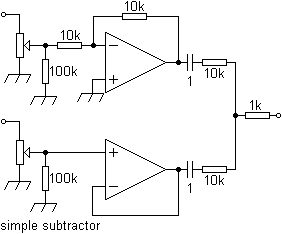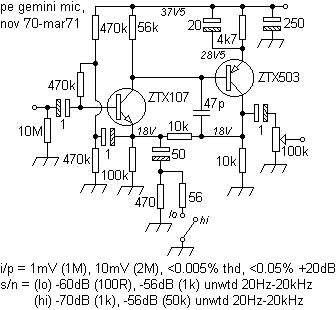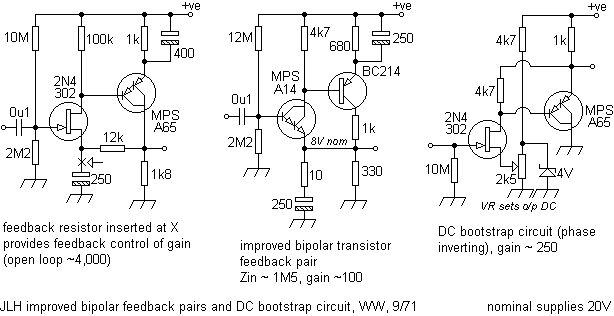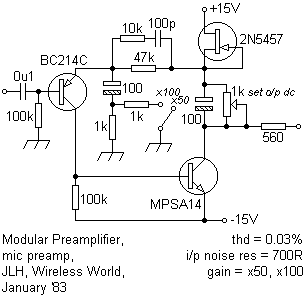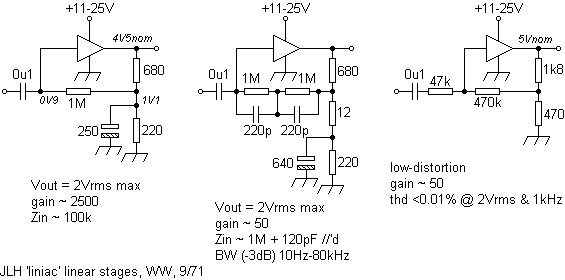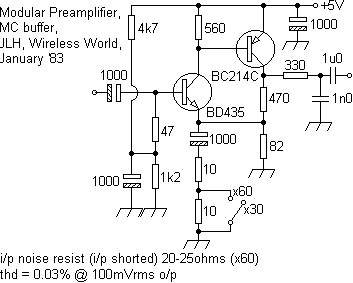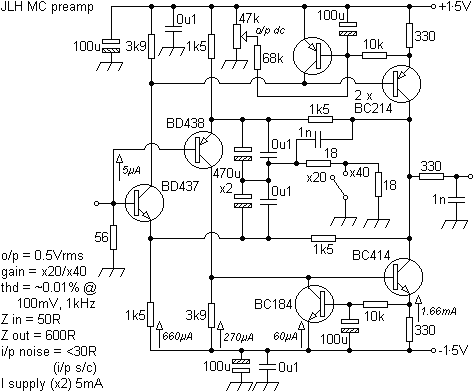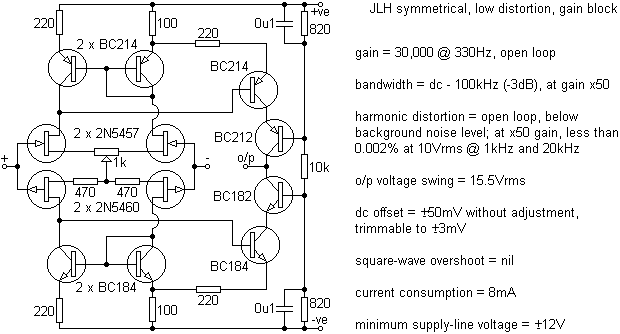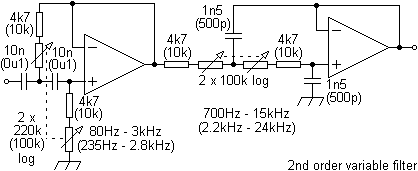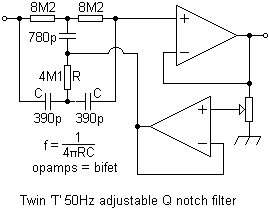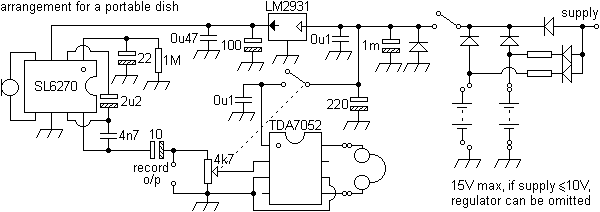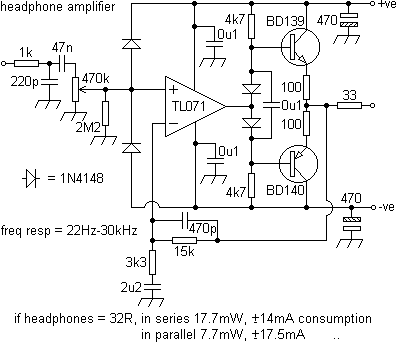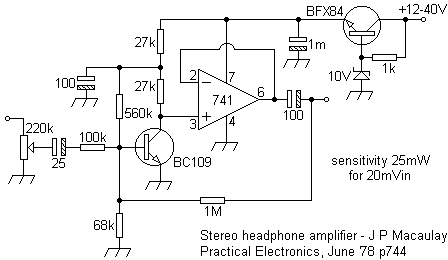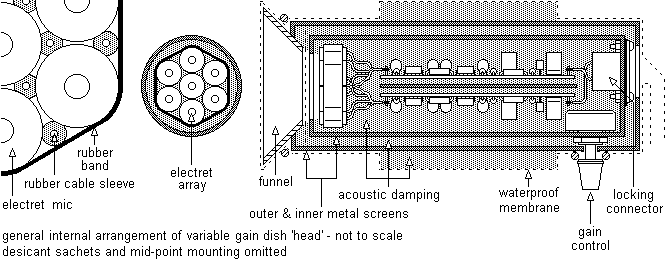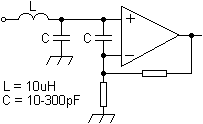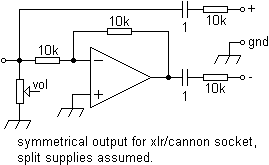Sound pickups
The dynamic microphone, very similar in form and function to the conventional loudspeaker, is the industry standard for most applications and is seen most frequently in the hands of a singer or presenter. However, situations can arise for which other solutions are required, say for example, if a microphone is to be worn, or if a miniature, high sensitivity or discrete approach is required. In such circumstances, hi-fi quality though possible may not be as important as proximity or placement in respect to the required source.
Proprietary systems can cost hundreds or even thousands, but surprising results can be obtained at a fraction of such costs.
When designing a sound pickup system a number of elements must be decided from the outset. The choice of microphone itself can be important. An omnidirectional type will pick up sound from all directions, whereas an unidirectional or cardioid type will exhibit a directional characteristic. A magnetic dynamic type may suit most applications offering a low internal noise figure. Electret or FET capsules, although offering higher noise, are far more sensitive (a chart comparing typical replacement capsules can be found at the bottom of the page). A choice of power source will be necessary, eg; mains, battery or both. At the same time, monitoring of an output may be required. Rugged water/weather-proofing will be vital for external use. Ideally, a complete system can be pulled out of a river, the water shaken off and be used immediately.
Sub-aqua applications have been seen where an (expensive) microphone is sealed within one or two condoms and then thrown into the sea. This approach is not recommended. A brief description of an inexpensive and effective hydrophone is given near the end of this page.
A radio-link can be useful but can suffer from disadvantages arising from weak signals, break-through, etc, especially if the source is mobile or the working environment is unknown or untested. The detection of an obvious RF source may be undesirable and encryption or frequency-hopping may be required to avoid interception. Code-division multiple-access (CDMA) has been used for many years by the military for covert and secure communications, since it is highly immune to interference, carries a high level of inherent security and can be made to appear indistinguishable from ordinary broad-band noise. Professional systems are available, some at very high cost, and can be very effective. However, unanticipated pitfalls can become apparent very quickly that can render even the best system useless. Most easily the commonest problem to address is how to survive being dropped, especially into water.
To increase directivity, say for video use, a 'zoom' facility will be required. JVC patented a method where FET mics were staggered in a vented tube. These could then be mixed into an amplifier in order to enhance the forward lobe by some 15dB. This system has been adopted world-wide with a wide variety of copies.

Sometimes a wanted signal will be submerged in extraneous noise and the actual placement of a microphone with respect to it's target can often be the major determining factor in terms of the quality of the signal obtained, a fact noted by recording engineers when say the close miking of a musical instrument reduces ambient reverberation giving a dead and lifeless quality to the recording. Electronic filtering and compression can improve intelligibility enormously, but simply piling on the amplification will not. Compact battery-driven systems will run down faster if forced to accommodate large and unnecessary signals. Low frequencies, in particular, can play havoc and these are best filtered out at the input. Roll-offs at -3dB of 1 or 2Hz are not productive if the intended target is, say, speech when 100Hz (-12dB) will give better results. In this case, an upper roll-off of 5kHz will meet most needs.
Since the operating noise level of a system can be largely due to the impedance of the source, the outputs of a number of microphones can be paralleled which then feed the input of a bus summing amplifier. Details of these are often found in the datasheets of specialist audio preamps. The layout of such an array can be important (see Bessel arrays).
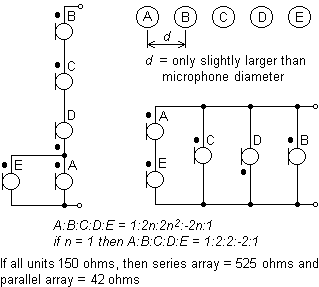
Simplicity is often the key to a successful system. With the advent of mobile phones and personal digital audio, recording that was previously dependent on tape as a storage medium, has been made much easier.
Tip: if, during a 'live' performance, conference or public meeting, a lead to a mixer, for whatever reason, decides to short or open-circuit much delay and embarrassment can arise. The following circuit can be left in circuit during use to provide an instant diagnosis. Obviously, the line tested must be devoid of DC.

Naturally, in critical situations, there should always be a backup.
Collectors
To increase sensitivity, some form of collector that focusses or directs acoustic energy on to a microphone is as important as an aerial is for a transmission receiver, often the overall performance of the system, regardless how expensive, being limited by this. Extreme examples are sound mirrors.
Experiments were tried with horns and parabolic dishes to focus acoustic energy. These proved adequate and, on occasion, interesting, especially when dealing with reflections, or providing a stereo output. Redundant satellite dishes can be re-used, thus reducing design and construction efforts, although perforated types will require 'smoothing'. However, for those interested here are three web-sites that offer advice on constructing circular parabolic types; one a simple technique, another built from cardboard and another for larger sizes. Other forms exist, for example offset types for microwaves, but most constructors will find the circular form easier to build.

Inaccuracies in a dish's form can be overcome by using a funnel to direct reflected acoustic energy to the microphone, thus offering a larger target area or 'throat'.
If the dish radius equals twice the focal length (f=y=1 and x=2), the microphone supports will be flat and easier to mount. However, the dish aperture will present a signal over a 180° arc to the sensor and, whilst this can be useful with solar heating applications, cancelling can occur. Most microphone apertures will normally be less than this, say 90°, in which case a dish diameter of say 2f can then 'waste' acoustic energy (if mic aperture <90° and f=1, then x=<1). A personally preferred ratio that is easy to remember is that if f=1 and x=root 2 (1.4142135), then y=½=0.5, this supporting a microphone aperture of 140° or less. When physically matching a microphone's 'throat' to a dish, substituting a light source for the microphone will easily identify areas of 'spillage' and 'wastage' in terms of literal illumination.
It must be borne in mind that the larger the diameter of a dish (usually some 0.3-1.2m for audio) the greater it's collecting area and consequent sensitivity will be. This must be weighed against the fact that the greater area of a larger dish can be problematic in high wind speeds in terms of mechanical stability. This can be seen in the table below.

Normally a compromise is required to reduce the dish diameter to a reasonable and manageable size whilst reducing cancellation effects and/or shielding the sensor from unwanted noise emanating from behind the dish. Similar considerations are necessary for storage and transport, since most dishes are not collapsible, together with means to easily demount the sensor and it's supports, whilst being able to remount them again with easily repeatable mechanical accuracy. At the same time, it must be remembered that the total acoustic energy from a large collector can easily destroy a delicate microphone if directed at an even intermittent powerful source (see below). In essence, and rather obviously, sensitive microphones require a smaller dish area than less sensitive types. An assumption that a microphone offering 20dB more sensitivity will require 20dB less dish area can be made although an empirical approach is recommended to determine the best match for any given situation, notwithstanding any spanners that Murphy might decide to throw into the works, susceptibility to extraneous noise being but one.
A microphone fed by a dish, apart from it's aperture (the diaphragm area), should be carefully shielded acoustically to prevent audio pickup from all directions other than that presented by the dish to reduce unwanted signals. Similarly, low frequencies, say from vehicles or strong winds, can make a flimsy dish resonate which can modulate and distort the incoming signal. The back can be ribbed to stiffen it, and can have rubber sheeting bonded to it to dampen vibrations. A ring fitted, or a lip formed, at a dish's edge will help to stiffen it and provide a stronger anchorage for the microphone's/dish's supports. Lightweight, stamped 1m dishes are ideal.
A proprietary solution might include a 20" (50.8cm) segmented and collapsible dish, tripod, amplifier with 3-band equaliser, headphones, quick assembly/disassembly, tape record, patch in of a communications device, adjustable volume for each ear, automatic safety shut off at 95 decibels, tripod mount for extended use and powered by 2 AAA batteries that last about 100 hours. In ideal conditions it might be claimed that it is possible to hear a conversation 300 yards away, with a weight of 1½lbs (0.68Kgs).
To increase the aperture diameter of a small FET mic, curved 'funnels' from redundant smoke alarm output transducers proved very effective, although for external use, some physical means of reducing the input of low frequencies may be required. A dynamic type is less prone to be driven into clipping.
Although potentially extremely effective, if discretion is required a dish is probably the least subtle approach possible unless circumstances allow the use of an obvious satellite dish that has been converted, for example. Under these circumstances, benefit can accrue if the dish is remotely steerable, although the system then may become unnecessarily complex, especially if a visual (camera) output is required as a consequence. Transparent (polyethylene, polycarbonate, etc) types can be obtained reducing visibility. However, the presence of these, if detected, will be a certain give-away. Mottled, drab paint finishes (with matching fabric overlays) can break up a dish's outline, with skill, to the point of invisibility.
In one situation, a wide area was covered by aiming a dish at a slight angle to a large wall adjacent to the target area, reflections from which gave the desired results. Architectural curves can give very distinct acoustic qualities to a building, the Whispering Gallery in St Paul's cathedral being a good example. Some chapels seen have curved ceilings that then merge into the walls presenting an unbroken surface. These tend to reflect any music and singing back down onto the congregation. One former Laura Ashley shop that had been extensively remodelled had a 'dish' in the ceiling above the till area. These principles have been observed in earlier times, for example, take Greek theatres or the very ancient Chalcolithic Goddess Temple on Malta which has chambers cut into the rock which to some ears are harmonic, and obviously resonant, like singing in the shower (see sonics).
Some satellite dishes are offset in that the head will not be aligned on the dish's centre-line but, in normal use, will be angled upwards. For audio, invert the dish so that the microphone is pointed towards the ground, thus helping to prevent the pick-up of aircraft noise, etc, and aiding weather-proofing. Offset types, when rotated 90°, can be more effective for stereo arrangements when two funnels are combined in one 'head' to direct sound on to separate mics. Other non-standard formats are workable too, eg;

Alternatively, for long range use, rifle mikes using a single 'barrel' have been used. These will usually consist of a pipe, open at one end with the mic at the other, to isolate the sound source aimed at. Perforations and damping prevent the tube from resonating.

More complex, but arguably more sensitive, is the 'shotgun' design described by James Hollinger and John Mulligan in the June 1964 edition of Popular Electronics (US). In this approach 37 3/8" aluminium tubes, each an inch shorter than the next (36" to 1") were combined in a hexagonal bundle which was then presented via a funnel to a single crystal microphone. Each tube resonates at a wavelength twice that of it's length giving exceptional sensitivity and directivity. In this case, a frequency response of 186 to 13,392Hz is covered (for speech, 24 tubes of 2-25" can suffice). An unwanted signal at a particular frequency can then be reduced by stopping the relevant tube/s. With the active pickup described below, sensitivity was greatly enhanced. To reduce noise further, say from power-lines or transmitters, a silver-loaded epoxy was used to bond the tubes which were then used as the primary earthing point (spiked out-of-doors).

